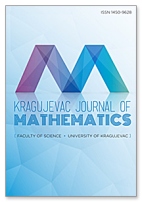Three Solutions for p-Hamiltonian Systems with Impulsive Effects
 Download PDF
Download PDF
Authors: H. HAGHSHENAS AND G. A. AFROUZI
DOI: 10.46793/KgJMat2304.499H
Abstract:
In this paper, we give some new criteria that guarantee the existence of at least three weak solutions to a p-Hamiltonian boundary value problem generated by impulsive effects. To ensure the existence of these solutions, we use variational methods and critical point theory as our main tools.
Keywords:
Weak solution, p-Hamiltonian boundary value problem, impulsive effect, critical point theory, variational methods.
References:
[1] G. A. Afrouzi, M. Bohner, G. Caristi, S. Heidarkhani and S. Moradi, An existence result for impulsive multi-point boundary value systems using a local minimization principle, J. Optim. Theory Appl. 177(1) (2018), 1–20. https://doi.org/10.1007/s10957-018-1253-1
[2] G. A. Afrouzi, A. Hadjian and V. D. Radulescu, Variational approach to fourth-order impulsive differential equations with two control parameters, Results Math. 65 (2014), 371–384. https://link.springer.com/article/10.1007/s00025-013-0351-5
[3] D. Averna and G. Bonanno, A three critical point theorem and its applications to the ordinary Dirichlet problem, Topol. Methods Nonlinear Anal. 22 (2003), 93–103. https://projecteuclid.org/euclid.tmna/1475266319
[4] D. D. Bainov and P. S. Simeonov, Systems with Impulse Effects, Ellis Horwood, Chichister, 1989.
[5] G. Bonanno, Some remarks on a three critical points theorem, Nonlinear Anal. 54 (2003), 651–665. https://doi.org/10.1016/S0362-546X(03)00092-0
[6] G. Cordaro and G. Rao, Three periodic solutions for perturbed second order Hamiltonian systems, J. Math. Anal. Appl. 359 (2009), 780–785. https://doi.org/10.1016/j.jmaa.2009.06.049
[7] G. D,Agui and G. M. Bisci, Three non-zero solutions for elliptic Neumann problems, Anal. Appl. 9 (2011), 383–394. https://doi.org/10.1142/S021953051100190X
[8] A. d,Onofrio, On pulse vaccination strategy in the SIR epidemic model with vertical transmission, Appl. Math. Lett. 18 (2005), 729–732. https://doi.org/10.1016/j.aml.2004.05.012
[9] F. Faraci, Multiple periodic solutions for second order systems with changing sign potential, J. Math. Anal. Appl. 319 (2006), 567–578. https://doi.org/10.1016/j.jmaa.2005.06.062
[10] J. R. Graef, S. Heidarkhani and L. Kong, Infinitely many periodic solutions to a class of perturbed second-order impulsive Hamiltonian systems, Differ. Equ. Appl. 9(2) (2017), 195–212. https://doi.org/10.7153/dea-09-16
[11] H. Gu and T. An, Existence of infinitely many periodic solutions for second-order Hamiltonian systems, Election. J. Differential Equations 2013(251) (2013), 1–10. https://ejde.math.txstate.edu
[12] M. Izydorek and J. Janczewska, Homoclinic solutions for a class of second order Hamiltonian systems, J. Differential Equations 219 (2005), 375–389. https://doi.org/10.1016/j.jde.2005.06.029
[13] V. Lakshmikantham, D. D. Bainov and P. S. Simeonov, Theory of Impulsive Differential Equations, Series in Modern Applied Mathematics 6, World Scientific, Singapore, 1989.
[14] C. Li, Z-Q. Qu and C-L. Tang, Three periodic solutions for p-Hamiltonian systems, Nonlinear Anal. 74 (2011), 1596–1606. https://dx.doi.org/10.1016/j.na.2010.10.030
[15] F. Liao and J. Sun, Variational approach to impulsive problems, A survey of recent results, Abstr. Appl. Anal. 2014(2) (2014), 1–11. https://dx.doi.org/10.1155/2014/382970
[16] J. Mawhin and M. Willem, Critical Point Theory and Hamiltonian Systems, Springer, New York, 1989.
[17] Q. Meng, Three periodic solutions for a class of ordinary p-Hamiltonian systems, Bound. Value Probl. 2014 (2014). https://doi.org/10.1186/s13661-014-0150-2
[18] G. M. Bisci, Fractional equations with bounded primitive, Appl. Math. Letters 27 (2014), 53–58. https://doi.org/10.1016/j.aml.2013.07.011
[19] G. M. Bisci and D. Repovš, Multiple solutions for elliptic equations involving a general operator in divergence form, Ann. Acad. Sci. Fenn. Math. 39 (2014), 259–273. https://doi.org/10.5186/aasfm.2014.3909
[20] S. I. Nenov, Impulsive controllability and optimization problems in population dynamics, Nonlinear Anal. 36 (1999), 881–890. https://doi.org/10.1016/S0362-546X(97)00627-5
[21] P. H. Rabinowitz, Variational methods for Hamiltonian systems, in: Handbook of Dynamical Systems, Vol. 1, Part A, North-Holland, 2002. https://doi.org/10.1016/S1874-575X(02)80016-9
[22] B. Ricceri, A three critical points theorem revisited, Nonlinear Anal. 70 (2009), 3084–3089. https://doi.org/10.1016/j.na.2008.04.010
[23] A. M. Samoilenko and N. A. Perestyuk, Impulsive Differential Equations, World Scientific, Singapore, 1995.
[24] X. Shang and J. Zhang, Three solutions for a perturbed Dirichlet boundary value problem involving the p-Laplacian, Nonlinear Anal. 72 (2010), 1417–1422. https://dx.doi.org/10.1016/j.na.2009.08.025
[25] T. Shen and W. Liu, Infinitely many rotating periodic solutions for suplinear second-order impulsive Hamiltonian systems, Appl. Math. Lett. 88 (2019), 164–170. https://doi.org/10.1016/j.aml.2018.08.026
[26] J. Sun, H. Chen and J. J. Nieto, Infinitely many solutions for second-order Hamiltonian system with impulsive effects, Math. Comput. Model. 54 (2011), 544–555. https://doi.org/10.1016/j.mcm.2011.02.044
[27] Z. Wang and J. Zhang, Periodic solutions of a class of second order non-autonomous Hamiltonian systems, Nonlinear Anal. 72 (2010), 4480–4487. https://doi.org/10.1016/j.na.2010.02.023
[28] B. Xu and C-L. Tang, Some existence results on periodic solutions of ordinary p-Laplacian systems, J. Math. Anal. Appl. 333 (2007), 1228–1236. https://doi.org/10.1016/j.jmaa.2006.11.051
[29] Q. Zhang and C. Liu, Infinitely many periodic solutions for second order Hamiltonian systems, J. Differential Equations 251 (2011), 816–833. https://doi.org/10.1016/j.jde.2011.05.021
[30] Q. Zhang and X. H. Tang, New existence of periodic solutions for second order non-autonomous Hamiltonian systems, J. Math. Anal. Appl. 369 (2010), 357–367. https://doi.org/10.1016/j.jmaa.2010.03.033
[31] X. Zhang and Y. Zhou, Periodic solutions of non-autonomous second order Hamiltonian systems, J. Math. Anal. Appl. 345 (2008), 929–933. https://doi.org/10.1016/j.jmaa.2008.05.026
[32] J. Zhou and Y. Li, Existence of solutions for a class of second-order Hamiltonian systems with impulsive effects, Nonlinear Anal. 72 (2010), 1594–1603. https://doi.org/10.1016/j.na.2009.08.041
[33] W. Zou and S. Li, Infinitely many solutions for Hamiltonian systems, J. Differential Equations 186 (2002), 141–164. https://doi.org/10.1016/S0022-0396(02)00005-0
